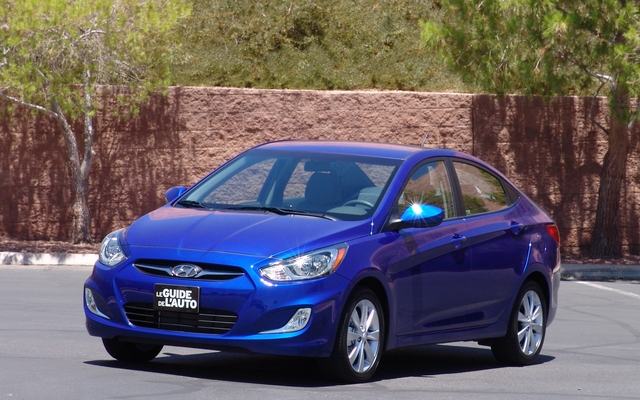2012 Hyundai Accent: More than a low price

The Accent, Hyundai’s popular sub-compact, is fresh off a complete makeover. The new generation has nothing in common with the previous one… and that’s good news!
Its lines are reminiscent of those of its big sister, the Elantra, especially when viewed from the front. The 2012 Accent is available in sedan and five-door hatchback versions. Personally, I find the hatchback’s style more dynamic and better suited to a small car, as is often the case (look at the Ford Fiesta and the Toyota Yaris, to name but two). Gone is the very affordable three-door that made getting a car a possibility for a lot of people. Several years ago, Hyundai even managed to drop the Accent’s base price below $10,000. It had to be done, even if the car’s standard equipment was a bit sad.
While it remains in the sub-compact category, the new Accent has upgraded its equipment, dimensions and aesthetics. The days of basing the marketing strategy solely on its low price are gone. Now the product’s other attributes are in the spotlight.
Genetically well-endowed
The Accent gained precious millimetres here and there, helping it offer a larger passenger compartment than most of its competitors, including the Ford Fiesta, Mazda2 and Toyota Yaris, among others. The wheelbase increases by 70 mm, adding to the overall length of the five-door hatchback. Five tiny millimetres were added to the width, but it’s now 20 mm lower, which gives it a stockier, more muscular look than before.
The previous generation’s dashboard was about as dynamic as an alarm clock in a power out, but it’s much better now. It’s simple, efficient and easy on the eyes. Even the materials are of considerably higher quality and more refined.
I usually find the seats in Korean cars rather hard on the back and backside, but in the Accent my body parts were just fine. There’s a 60/40 folding rear bench (but it doesn’t fold down completely flat) that increases the size of its already fairly large trunk – especially in the hatchback – even more. However, its high loading height may be problematic for transporting heavy items. Incidentally, the sedan’s trunk opening is big enough.
Enter the Gamma
The 1.6-litre four-cylinder is the only engine type available, and it has the same capacity as the previous engine. But don’t be fooled. This engine, the Gamma, is brand new and very modern with direct fuel injection, dual variable valve timing and offset crankshaft to reduce friction within the cylinders, and so on. This engine is more powerful than before and features more torque. Also note that it’s more fuel efficient than it used to be (the previous generation wasn’t exactly a teetotaller so it isn’t hard to beat…) and promises to be more environmentally-friendly. Hyundai is advertising 6.7 litres in town with the manual transmission and 7.0 litres for the automatic.
Like the engine, both of the available transmissions are brand new. There’s a six-speed manual and a six-speed automatic with manual mode.
The chassis is unique, although it shares some features with the chassis used in the previous generation. There’s still a MacPherson strut front suspension while there’s a torsion bar suspension in back.
That’s all well and good, but how is it on the road? As you’d suspect, the handling on the new Accent is light-years ahead of what the old generation offered. The power, despite substantial gains, isn’t great. Sure, improvements have been made, but the Honda Fit, for example, is better in terms of accelerations and pick-up. Particularly for passing, it would be nice to have a little more muscle. The power isn’t really noticeable at less than 3,500 rpm, which may end up being a clear disadvantage for anyone who doesn’t like to play around with the stick shift.
Formula One and Subaru
Speaking of the stick, the precision and the course of the manual are respectable, nothing more and nothing less. But compared to the generation it’s replacing, it’s like an F1 stick shift! The clutch is still a little soft but it’s head and shoulders above the previous clutch. As for the automatic, it has an anti-rollback mode, a little like a Subaru. It’s good, but it should the manual that comes with that feature!
The passenger compartment is well soundproofed (except when the engine revs higher than 3,500 rpm) and the very precise steering offers decent feedback, which is new for an Accent. It’s very tough for us to describe the work of the suspensions given that we test drove the car on the perfect roads of Nevada, but we did take a few corners a little faster than we should have, and there was no evidence of an abnormal roll for the category. On the other hand, if Hyundai replaced the lowly Khumo Solus tires, handling could only improve. Interestingly, all versions of the Accent have four disc brakes. That looks good on paper, but I believe that good drum brakes would have done the job perfectly and would cost less to maintain.
A few years back, adulation greeted everything that came out of Japanese plants. Today, that honour belongs to the Koreans, and the Hyundai Accent deserves all of the praise that it’s getting.









